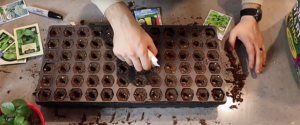Shallots

Health Power
See Onions, which have similar vitamins, minerals and phytonutrients.
Vitamin and Mineral Content
Vitamins – C, B6 (Pyridoxine), B9 (Folate), B1 (Thiamin) and B2 (Riboflavin)
Minerals – Manganese, Potassium, Phosphorus, Magnesium and Calcium
Disease Prevention
See Onions
How to Grow
Shallots are a smaller version of the main crop onion with a mild flavor. Harvest them earlier than main crops, too. Shallots need a site with full sunshine and soil full of organic matter. Work in a generous amount of aged compost or planting mix. The pH should be above 6.5; add lime to raise if needed. Shallots are most easily grown from sets (last year’s bulbs). Try to choose a variety that stores well for the following year’s crop. Remove any dead growth from the top of the bulb and plant in drills in spring. Place each bulb 6 inches apart. Barely cover the tip of the bulb with soil. Don’t pack the soil down around the bulb, as this will make them pop themselves out when they start to grow roots. They grow best in looser soil that allows for their bulbs to expand and roots to grow without much resistance. Space the rows out by 1 foot and stagger them so sets do not grow right next to each other. Weed as necessary and water during dry weather. Early in summer, loosen the soil around the bulbs to help them ripen up. They are ready for harvest when the foliage dies off. Lift them out, brush the bulbs clean and store. Ideally, put them on a net for optimal airflow, but storing them in perforated sacks in a cool, dry, frost-free place works, too.
Insect Control
Shallots usually grow trouble free. If you cannot control an infestation by hand, and it threatens the welfare of the crop, consult a local nursery or agricultural extension office.
Tips
In warmer climates, plant shallots in the fall and take them through winter. Exposure to cool temperatures makes a larger, more flavorful shallot. If your soil is at all dense and drainage is an issue, plant shallots in raised ridges.
___________________________________________________________________________________
What do you need to start indoor growing?
It’s easy to buy your transplants from the garden center each season, but there are lots of reasons to sprout your own seeds at home. It will save a substantial amount of money, you’ll have access to a wider range of plant varieties, and you’ll have the satisfaction of seeing a plant through its full life cycle. But if you’re a new seed sprouter. It’s really quite simple once you understand the basics. So if you’re ready to get sprouting, here are the basic steps to follow.






